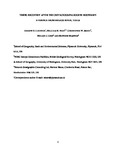Timing recovery after the Cretaceous/Paleogene boundary: evidence from the Brazos River, Texas, USA
| dc.contributor.author | Leighton, AD | |
| dc.contributor.author | Hart, Malcolm | |
| dc.contributor.author | Smart, Christopher | |
| dc.contributor.author | Leng, MJ | |
| dc.contributor.author | Hampton, M | |
| dc.date.accessioned | 2017-07-27T14:03:12Z | |
| dc.date.available | 2017-07-27T14:03:12Z | |
| dc.date.issued | 2017-07-01 | |
| dc.identifier.issn | 0096-1191 | |
| dc.identifier.uri | http://hdl.handle.net/10026.1/9646 | |
| dc.description.abstract |
As part of an on-going re-assessment of the Creta-ceous/Paleogene boundary in the Brazos River area, Falls County, Texas, a number of new exposures have been described. One of these, at River Bank South, provides a near-continuous record of the lowermost Paleocene. It is from this succession that stable isotope analysis of bulk organic matter (δ13C and C/N) and mono-specific samples of the benthic foraminifera Lenticulina rotulata Lamarck (δ180 and δ13C) yields an orbitally-tuned stable isotope record, which allows the timing of events adjacent to the Cretaceous/Paleogene boundary to be determined. Using this cyclicity, it is suggested that the on-set of biotic recovery began ∼40, 000 years after the impact (near the base of Zone Pα) and that more significant recovery of planktic foraminifera and calcareous nannofossils began close to the base of Zone P1a, some 85, 000-100, 000 years post-impact. The data also appear to record the presence of the earliest Paleocene DAN-C2 and Lower C29n hyperthermal events and that these events appear to be an accentuated segment of this orbital cyclicity. | |
| dc.format.extent | 229-238 | |
| dc.language | en | |
| dc.language.iso | en | |
| dc.publisher | Cushman Foundation for Foraminiferal Research | |
| dc.subject | 2.1 Biological and endogenous factors | |
| dc.title | Timing recovery after the Cretaceous/Paleogene boundary: evidence from the Brazos River, Texas, USA | |
| dc.type | journal-article | |
| dc.type | Review | |
| dc.type | Journal | |
| plymouth.author-url | https://www.webofscience.com/api/gateway?GWVersion=2&SrcApp=PARTNER_APP&SrcAuth=LinksAMR&KeyUT=WOS:000418395400001&DestLinkType=FullRecord&DestApp=ALL_WOS&UsrCustomerID=11bb513d99f797142bcfeffcc58ea008 | |
| plymouth.issue | 3 | |
| plymouth.volume | 47 | |
| plymouth.publication-status | Published | |
| plymouth.journal | Journal of Foraminiferal Research | |
| dc.identifier.doi | 10.2113/gsjfr.47.3.229 | |
| plymouth.organisational-group | /Plymouth | |
| plymouth.organisational-group | /Plymouth/Faculty of Science and Engineering | |
| plymouth.organisational-group | /Plymouth/Faculty of Science and Engineering/School of Geography, Earth and Environmental Sciences | |
| plymouth.organisational-group | /Plymouth/REF 2021 Researchers by UoA | |
| plymouth.organisational-group | /Plymouth/REF 2021 Researchers by UoA/UoA07 Earth Systems and Environmental Sciences | |
| plymouth.organisational-group | /Plymouth/Research Groups | |
| plymouth.organisational-group | /Plymouth/Research Groups/Marine Institute | |
| plymouth.organisational-group | /Plymouth/Users by role | |
| plymouth.organisational-group | /Plymouth/Users by role/Academics | |
| dcterms.dateAccepted | 2017-03-22 | |
| dc.rights.embargoperiod | Not known | |
| rioxxterms.versionofrecord | 10.2113/gsjfr.47.3.229 | |
| rioxxterms.licenseref.uri | http://www.rioxx.net/licenses/all-rights-reserved | |
| rioxxterms.licenseref.startdate | 2017-07-01 | |
| rioxxterms.type | Journal Article/Review |


